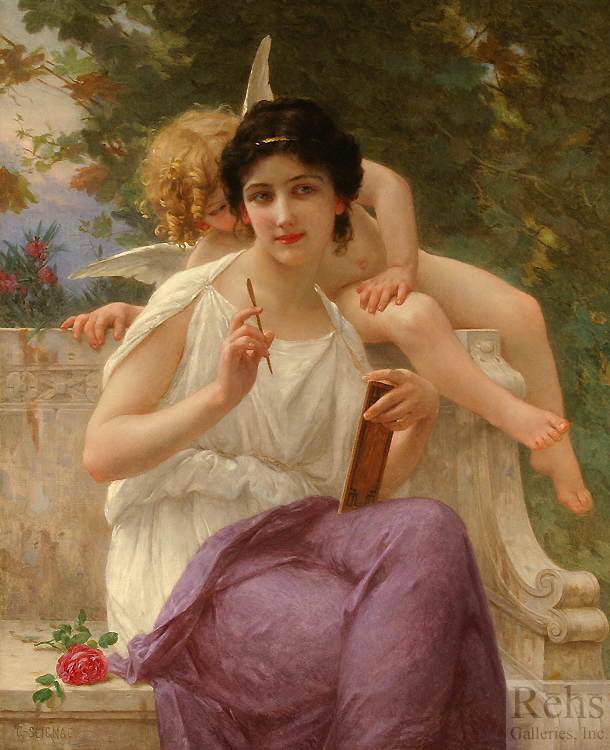Guillaume Seignac
(1870 - 1924)
L'Inspiration
Oil on canvas
39 1/2 x 32 inches
Signed
BIOGRAPHY - Guillaume Seignac (1870 - 1924)
Guillaume Seignac was not only trained in the academic style of the Ecole des Beaux-arts, but he also embraced the classical subject matter of the renaissance. In particular, he specialized in allegorical subjects and mythological figures from antiquity; idealized female nudes based on Greek and Roman prototypes were a perennial favorite. Frequently, Seignac’s paintings depict an allegorical female figure embodying an abstract concept such as “meditation” or “reverie,” usually in a setting that showcases a lush landscape furnished with Greek urns, ancient Roman fountains or Pompeian benches.
Seignac’s instructors at the Ecole des Beaux-arts, William Bouguereau, Tony Robert-Fleury and Gabriel Ferrier, undoubtedly nurtured his appreciation for traditional subject matter based on the seventeenth century French canon of Nicolas Poussin as well as the neo-classicists of the early nineteenth century. As with most academically trained painters, Seignac’s technical skills were formidable; drawing the human figure was highly prized, and understanding the compositional strategies of Italian renaissance painters would have been a basic element of any artist’s professional education. Similarly, the color harmonies found in the paintings of Raphael, balancing warm and cool hues, were held up to Ecole students as an ideal example.
In Seignac’s painting, however, there is also a fascination with the contrapposto poses typical of the figures in Michelangelo’s Sistine Chapel ceiling fresco. Works such as Beauty at the Well (Private Collection) or Confidence (Private Collection), for example, position the woman’s body so that she is turning in space according to the standards originally established by Polykleitos in his famous Canon of Proportions from c. 450 BCE. As advised by the ancient Athenian sculptor, the women in Seignac’s paintings are shown with one leg engaged and the other leg relaxed, while the opposite arm is either engaged or relaxed. Shoulders angle downward while hips angle upwards and the head is often tilted at a 45-degree angle to the plane of the torso. This method allows Seignac not only to pay homage to the proportional ideal of western beauty, but also to create a more dynamic composition using a solitary figure.
The same type of attention to a classical standard may be seen in Seignac’s extraordinary handling of diaphanous drapery. Whether depicting a modest woman swathed head-to-toe in a Greek-styled garment or a semi-nude nymph clad only in transparent cloth, Seignac uses drapery to reveal the body beneath the fabric. In using this technique, he is again drawing from ancient Greek sources, such as the Parthenon sculptor Phidias, as well as the work of quattrocento artists like Botticelli. Throughout his work, Seignac demonstrates the strength of his education at the academy, and his personal ability to develop imagery that spoke to a contemporary audience in belle époque Paris.
Born in Rennes in 1870, Seignac’s career flourished in the midst of the tumultuous fin-de-siècle art world of Paris—an environment that nourished a wealth of artistic developments from the commercial poster art of Toulouse-Lautrec to the private abstractions of Bonnard and Vuillard to the ever-popular paintings of Jules Breton. In addition, the closing decade of the nineteenth century saw the growth of private galleries in Paris, and the simultaneous evolution of the annual Salon into a more impartial exhibition venue.
Beginning in 1897, Seignac exhibited regularly at the Salon des Artistes Françaises, winning an honorable mention in 1900, and a Third Class medal in 1903. The painter’s move to the Montparnasse neighborhood in 1902 [Boulevard du Montparnasse, 84] suggests that he was enjoying at least a modicum of financial success as well. During these productive years, Seignac’s characteristic images of beautiful young women with flowing hair and diaphanous clothing appealed to both the traditional art buyer and the more avant-garde connoisseur who looked for imagery that incorporated some of Art Nouveau’s sinuous curves and flirtatious allure. Like the English artists Albert Moore or Lawrence Alma-Tadema, Seignac was able to combine a contemporary sensuality with historical references to antiquity.
By 1907, Seignac’s reputation seems to have been well established when his friend, Pierre Antoine Laurent, sculpted a life-size bronze bust of the painter with the inscription, “A mon ami Seignac” [To my friend, Seignac], which is now in the Musée des Beaux-arts in Rennes.
Auction records indicate that Seignac’s paintings were selling well in New York and London, as well as Paris, in the decade before World War I. Allegorical subjects with classical references such as Youth and Love or Young Girl from Pompeii in a Garden were especially popular with American audiences, both before the war and in the 1920s. With Seignac’s death in 1924, and the subsequent decade of the Great Depression, art sales dwindled, but then revived quickly in the 1940s. Paintings depicting domestic subjects, as in Children in the Kitchen or Young Girl at a Well, were most sought after during the 1950s and 60s, while Seignac’s idealized nudes began attracting market attention in the 1970s and later. Since the 1990s Seignac’s work has enjoyed a notable resurgence of interest, in large part because of the art historical re-evaluation of work produced by academically trained painters.
Janet Whitmore, Ph.D.
Selected Museums
Smith College Museum of Art
Phoenix Art Museum
Fine Arts Museums of San Francisco
Works Exhibited at the Salon des Artistes Françaises, Paris
1897 - Bacchante
Les dernières roses [The Last Roses]
1898 - Flore
Tête grecque [Greek head]
1899 - Reverie
Diane
1900 - Baigneuse [Bathing]
1901 - L’attents [Waiting]
A la fontaine [At the Fountain]
1902 - Nymphe
Pensive
1903 - Secret d’amour [Love’s secret]
Irene
1904 - Le reveil de Psyché [Awakening of Psyche]
Hésitation

